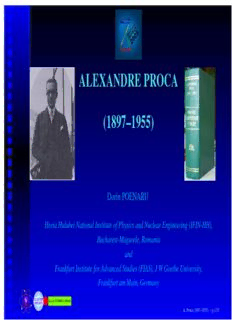
alexandre proca PDF
Preview alexandre proca
ALEXANDRE PROCA (1897–1955) Dorin POENARU Horia Hulubei National Institute of Physics and Nuclear Engineering (IFIN-HH), Bucharest-Magurele, Romania and Frankfurt Institute for Advanced Studies (FIAS), J W Goethe University, Frankfurt am Main, Germany CD CLUSTER DorinN.POENARU,IFIN-HH DECAYS A.Proca(1897–1955) –p.1/35 OUTLINE • Chronology • Impact on various branches of theoretical physics • Particles • Relativistic quantum fields • Klein-Gordon fields • Dirac field • Maxwell and Proca field • Hideki Yukawa and the Strong interaction • Einstein-Proca gravity. Dark matter, black holes. Tachyons. CD CLUSTER DorinN.POENARU,IFIN-HH DECAYS A.Proca(1897–1955) –p.2/35 Chronology I • 1897 October 16: born in Bucharest • 1915 Graduate of the Gheorghe Lazar high school • 1917–18 Military School and 1st world war • 1918–22 student Polytechnical School (PS), Electromechanics • 1922–23 Engineer Electrical Society, Câmpina, and assistant professor of Electricity, PS Bucharest • 1923 Move to France: “I have something to say in Physics” • 1925 Graduate of Science Faculty, Sorbonne University, Paris • 1930 Editor-in-chief: Annales de l’Institut Henri Poincaré CD CLUSTER DorinN.POENARU,IFIN-HH DECAYS A.Proca(1897–1955) –p.3/35 Chronology II • 1925–27 researcher, Institut du Radium. Appreciated by Marie Curie • 1930–31 French citizen. L. de Broglie’s PhD student. Marie Berthe Manolesco became his wife • 1931–33 Boursier de Recherches, Institut Henri Poincaré • 1933 PhD thesis. Commission: Jean Perrin, L. Brillouin, L. de Broglie. Chargé de Recherches. After many years Proca will be Directeur de Recherches • 1934 One year with E. Schrödinger in Berlin and few months with N. Bohr in Copenhagen (met Heisenberg and Gamow) CD CLUSTER DorinN.POENARU,IFIN-HH DECAYS A.Proca(1897–1955) –p.4/35 Chronology III • 1936–41 Proca equations. Massive spin-1 quantum field • 1938 Papers related to Proca eqs. by Yukawa, Wentzel, Taketani, Sakata, Kemmer, Heitler, Fröhlich, Bhabha • 1939 Proca invited to attend the Solvay Congress. 2nd world war. Chief Engineer of the French Radiobroadcasting Company • 1949 H Yukawa — Nobel prize for the meson theory of nuclear forces • 1943 Lectures at University of Portô, Portugal • 1943–45 UK: invited by Royal Society and British Admiralty to join the war effort. CD CLUSTER DorinN.POENARU,IFIN-HH DECAYS A.Proca(1897–1955) –p.5/35 Chronology IV • 1946 start the Proca Seminar with many prestigious invited speakers • 1949 and 1950 Attempts to get a chair of Physics at the Sorbonne University and College de France failed • 1950 with P. Auger organizers of the Theoretical Physics Colloquium of CNRS • 1951 French delegate, General Meeting of International Union of Physics • 1953–55 laryngeal cancer • 1955 December 13: A. Proca passed away CD CLUSTER DorinN.POENARU,IFIN-HH DECAYS A.Proca(1897–1955) –p.6/35 PACS (Physics & Astronomy Classification Scheme) • 03. Quantum mechanics, field theories, and special relativity • 03.50.-z Classical field theories • 03.50.De Classical electromagnetism, Maxwell equations • 03.70.+k Theory of quantized fields • 04. General relativity and gravitation • 04.50.+h Gravity in more than four dimensions, Kaluza-Klein theory, unified field theories; alternative theories of gravity • 04.60.-m Quantum gravity • 04.70.-s Physics of black holes • 04.70.Bw Classical black holes • Quantum aspects of black holes, evaporation, thermodynamics • 11. General theory of fields and particles • 11.10.-z Field theory • 11.10.Kk Field theories in dimensions other than four • 11.15.-q Gauge field theories • 11.30.Cp Lorentz and Poincare invariance • 12. Specific theories and interaction models; particle systematics • 12.20.-m Quantum electrodynamics • 12.38.-t Quantum chromodynamics • 12.40.Vv Vector-meson dominance CD CLUSTER DorinN.POENARU,IFIN-HH DECAYS A.Proca(1897–1955) –p.7/35 Particles ~ The projection of angular momentum is l , with l integer z z −l ≤ l ≤ l. The intrinsic angular momentum, s, is called spin. z • fermions, s = (n + 1/2)~, n integer • spinor, s = ~/2, e.g. leptons (e, ν, µ, τ) • spinor-vector, s = (3/2)~ • bosons, s = n~ • scalar, s = 0, • vector, s = ~, e.g. mesons (ω, ρ), m = 0 photons, ± 0 weak (massive W , Z bosons), m = 0 gluons • tensor, s = 2~, e.g. graviton Vector bosons are mediators of three (of the four) fundamental interactions in particle physics: electromagnetic, weak, and strong. Tensor bosons are assumed to mediate the gravitation. CD CLUSTER DorinN.POENARU,IFIN-HH DECAYS A.Proca(1897–1955) –p.8/35 Fundamental interactions FORCE RANGE TRANSMITTED BY BOSONS gravity long graviton, massless, spin 2 electro- long photon (γ), massless, spin 1 magnetism ± 0 weak short W , Z , heavy, spin 1 interaction strong short gluons (g), massless, spin 1 interaction CD CLUSTER DorinN.POENARU,IFIN-HH DECAYS A.Proca(1897–1955) –p.9/35 Relativistic quantum fields A particle is a localized entity. A field occupies a region of space. Einstein’s special theory of relativity allows for the existence of scalar, vector, tensor, fields. Examples • Klein-Gordon (s = 0) • Dirac (s = 1/2) • Proca (s = 1, m 6= 0) • Maxwell (s = 1, m = 0) • Rarita-Schwinger (s = 3/2) • Gravitation (s = 2) CD CLUSTER DorinN.POENARU,IFIN-HH DECAYS A.Proca(1897–1955) –p.10/35
Description: